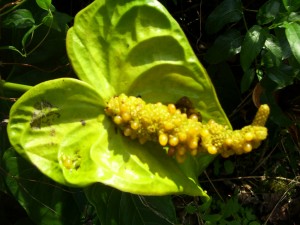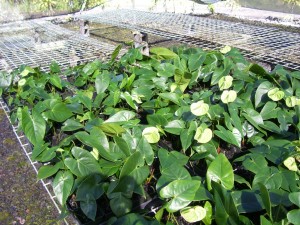Anthurium Propagation: Seeds, Cuttings & Tissue Culture
There are three ways to propagate anthurium plants: you can take cuttings; you can grow them from seeds; or you can tissue culture them. Cuttings are easy for anyone to do. Seeds are a little more difficult to do, and tissue culture is generally reserved for scientists in labs or really advanced anthurium cultivators.
Anthurium Cuttings
Cuttings are by far the easiest way to propagate your anthurium plant. The best part about taking cuttings is that the plants you produce will look exactly the same as the parent plant. First, you must wait until your plant is big enough to allow a cutting to be taken. Generally you’ll want to see at least four nodes, or sets of leaves and roots, before taking a cutting. Once your plant is big enough, cut it in half, so that each portion has at least two nodes. Leave the base of your plant in its original pot and it will generate new growth. Then put the top cutting into a new pot, water it regularly and it will keep growing, too.
Anthurium Seeds
Anthurium seeds are another way to propagate your plant. However it is a much more difficult process and takes a lot more patience. The stigma and stamen of these flowers are active at different times, so if you want to produce seeds you will have to store pollen in the freezer or have two flowers at different stages of development. So the first thing you have to do is gather pollen. Use a paint brush to scrape pollen off the stamen and into a vial. Keep this vial in the freezer until you see that the stigmas are ready to be pollinated. Once you have a flower with receptive stigmas dust a little pollen over it. Next you will have to wait for approximately a year for seeds to be produced.
Anthurium Tissue Culture
Tissue culture is almost exclusive done within the confines of a lab, with the exception of really high end hobbyists and growers. It is best left to commercial growers because it is very expensive and is generally used when one wants to produce thousands of genetically identical plants. So how does an anthurium farmer tissue culture an anthurium plant?
First, the anthurium farmer chooses an ideal specimen. This specimen will be replicated thousands of times, so a lot of time and effort is put into choosing the very best specimen available. Once this precious plant is selected, the farmer takes it to a lab.
In the lab, a scientist confirms that the specimen is healthy and then chops off a piece of it. Then the scientist will sterilize the sample and put it into a beaker that contains an agar based gel. This beaker also contains special plant hormones that trigger the sample to form a callus, which is an undifferentiated mass of plant cells.
The callus is divided into many portions and then allowed to grow once more. This method is replicated multiple times. Once sufficient material is created, the calluses are moved to a growing media which contains plant hormones that cause the undifferentiated cells to transform into roots and shoots. This causes hundreds of plantlets to sprout from every callus.
After the plantlets have grown sufficiently, they’re transplanted into brand new flasks to mature further. Once they have reached a size where they can survive in open air, they are removed from the beakers and transferred into pots. These new plants are allowed to mature in the tightly controlled conditions of a plant nursery for a while. Then, after they have adjusted to growing in open air, they’re returned to the farmer for transplanting into his fields.
Anthurium Seeds: A Brief Guide To Anthurium Pollination
Most people propagate their anthurium plants through cuttings. But the downfall of this approach is that the offspring that is produced is identical to the parent plant. If you want variety in the anthurium flowers that you produce, you will need to learn how to pollinate your anthuriums in order to get them to produce seeds. The plants that you grow from these seeds will have traits from both of their parent plants, but sometimes you can get something completely unexpected due the presence of recessive traits. The most challenging element about growing anthuriums from seeds is getting the seeds to form in the first place. To do this, you will need to learn about anthurium pollination.
These flowers have both male and female components, but usually they won’t self pollinate, because the stigma is active before pollen is produced. This ensures that wild plants are cross pollinated as frequently as possible to improve the genetic diversity of the species.
The first thing you must do is gather pollen. Wait until the flower produces pollen and use a brush to collect the pollen in a vial. Store this vial inside a freezer until another flower is ready for pollination. Or use the pollen immediately if another flower is already ready for pollination.
After a flower blooms, wait for the stigma to secrete nectar. When this happens, the flower is ready for pollination. Use your brush to dust pollen over the stigmas. Then all you need to do is wait until seeds are formed.
You may have to wait for a full year for the seeds to mature. They are mature when they stop growing and start to fall off the spadix. Pop the berries that contain the seeds and plant them immediately. After a couple of weeks, the seeds will begin to grow and then, you will only have to wait another two to three years to find out what the new flowers you have created will look like. It takes about two to three years for anthuriums to produce their first flowers after sprouting from seeds.



